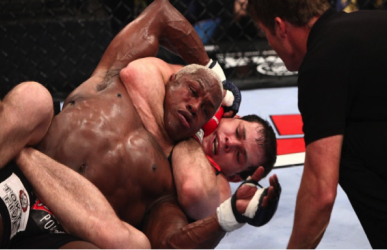In my previous post we discussed ‘blood chokes” and how they actually work. But it is important to note that not all chokes are blood chokes and, although the most common type of rear naked choke seen in MMA is the blood choke version, in actuality, not all RNCs are blood versions either.
There is a set of chokes that attack the windpipe directly to stop the opponent’s ability to breathe. In the martial arts, particularly Judo and Brazilian Jiu-jitsu, these are commonly referred to as “air chokes.” There are many types of air chokes from many, many different positions, but in this article I would like to specifically focus on the air choke variant of the RNC.
In the traditional Japanese grappling arts both the blood and air versions of the RNC usually share the same term “Hadaka Jime.” Likely, the samurai of years ago didn’t really care how they got the finish, just that they could defeat their opponents and survive.
This lack of distinction carried over to modern Judo. It is a shame because the two variations work in completely different ways and have different safety concerns.
In the BJJ world I have encountered more of a distinction, and there are a number of instructors who refer to the blood version as the “Lion Killer” (Mata Leão) and the air version as the “Bear Killer” (Mata Urso). So from here on I will refer to the air choke version depicted below as the Bear Killer.


As you can see, unlike the blood version, in the Bear Killer RNC the elbow of the choking arm is far to the side and not in the front centerline of the opponent. There is absolutely no contact on the carotid arteries or the vagus nerves, rather the pressure is directly on the windpipe. The distinction in position matters a lot: air chokes like the Bear Killer work by directly attacking the airway and restricting the intake of oxygen. So unlike the blood RNC which causes vasovagal pressure effects, air chokes are true hypoxia induction mechanisms.
But more importantly, there are a large number of soft tissue and bone structures in the throat that can be severely damaged by even a weak application of a Bear Killer.
To get the most efficient tap out, the optimal target of a Bear Killer RNC is the hyaline cartilage structure that sits in front of the larynx, near the hyoid bone, A secondary but still effective target is the cricoid cartilage, which sits lower and closer to the trachea.

Targeting either of these two areas with the Bear Killer is precisely what makes this choke so effective and so dangerous.
Targeting the Hyoid Bone & Hyaline Cartilage
The hyoid bone is a U-shaped bony structure situated in the front of the neck, in the angle between the mandible and the thyroid cartilage. Its name is originally Greek and derives from the bone’s resemblance to the letter upsilon (in that it has a curved body with two greater and two lesser horns). The primary function of hyoid bone is to provide attachment to the tongue, the larynx and the pharynx. But it has a variety of
other roles in humans (including assisting in sound production, smooth function of the airway, and swallowing). It is not only a critical piece of anatomy, it is also quite fragile. Additionally, the hyaline cartilage in the surrounding area, while providing some elasticity, is not known for high levels of mobility or flexibility.
Damage to these two areas can be severe. When thinking about the choke and its consequences, one thing to consider is that in recorded homicides by strangulation or hanging nearly 76% of cases showed some fracture of the hyoid bone. As the Bear Killer choke can directly attack this structure it is extraordinarily easy to either fracture the hyoid or to damage the nearby cartilage. Sometimes such damage will necessitate aggressive treatment such as surgical repair or a tracheotomy.
Targeting the Trachea & Cricoid Cartilage
Using leverage, Judo, Jiu-jitsu and MMA fighters are capable of applying chokes in excess of 100 pounds of force. Research has found that the trachea will collapse under 33 pounds of pressure. The cricoid cartilage will fracture under 45 pounds of pressure.
According to a study on cricoid fractures after physical assault that appeared in the Journal of Trauma:
Laryngotracheal trauma is a rare injury that can have devastating consequences… [such trauma] can lead to acute loss of an airway or chronic long-term problems.
Even in cases where there is no fracture, trauma to the tracheal structures may lead to swelling of the airway and or surrounding tissues (especially for individuals with asthma or other respiratory issues), which may in turn lead to acute respiratory occlusion and or delayed death.
Air Chokes in MMA
There have been many successful applications of air chokes in MMA. In particular the Bear Killer has been the deciding move in some very high profile fights including Roger Gracie’s win over Kevin Randleman. We can see in the picture below that Gracie has dominated the back position but his arm is constricting the airway rather than the sides of the neck.

But probably the most high profile use of a Bear Killer finish was in Nate Diaz’s spectacular victory over Connor MacGregor in their first fight in . As we can see Nate has secured the neck and is squeezing like an anaconda. His forearm is brutally crushing the Irishman’s airway, which quickly forced the tap.

The bear Killer is a powerful weapon in both MMA and self defense. But it is one that should be practiced with care in the academy and with a knowledge of how damaging the hold can be.
Tragic Applications in Street Altercations
In terms of use in street altercations, the application of an extended bear killer air choke targeting the trachea was, according to the forensic evidence, what led to the tragic death of Mr. Eric Garner. However, in Mr. Garner’s case the hyoid bone was not fractured. In the image below we can see the position of the forearm and pressure from the radius bone against Mr. Garner’s airway. Asthma was cited as a contributing factor, which is the element of the Bear Killer choke that is most different from the carotid blood choke version. Extended applications of a bear killer to asthamtic individuals are potentially extremely dangerous.

